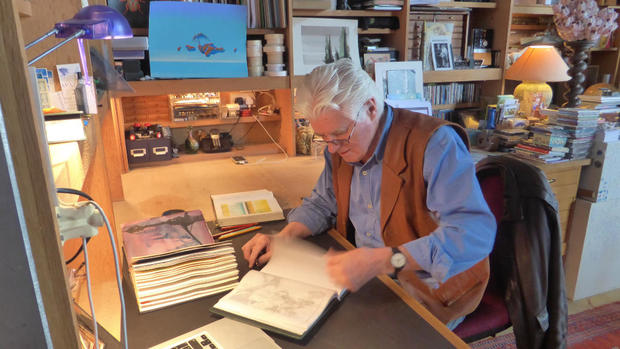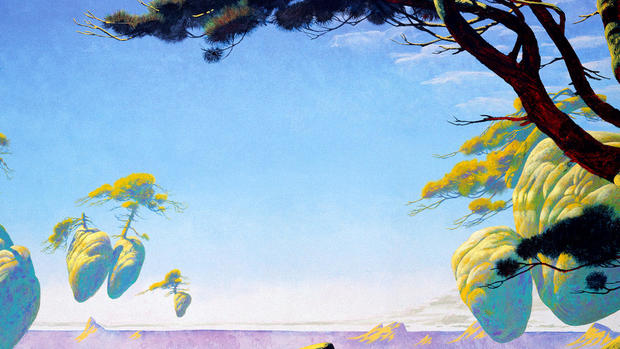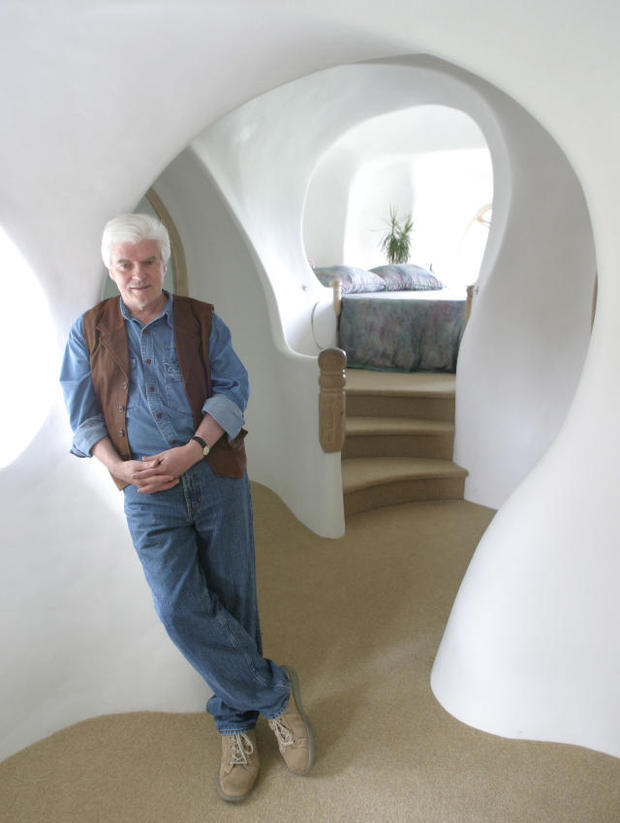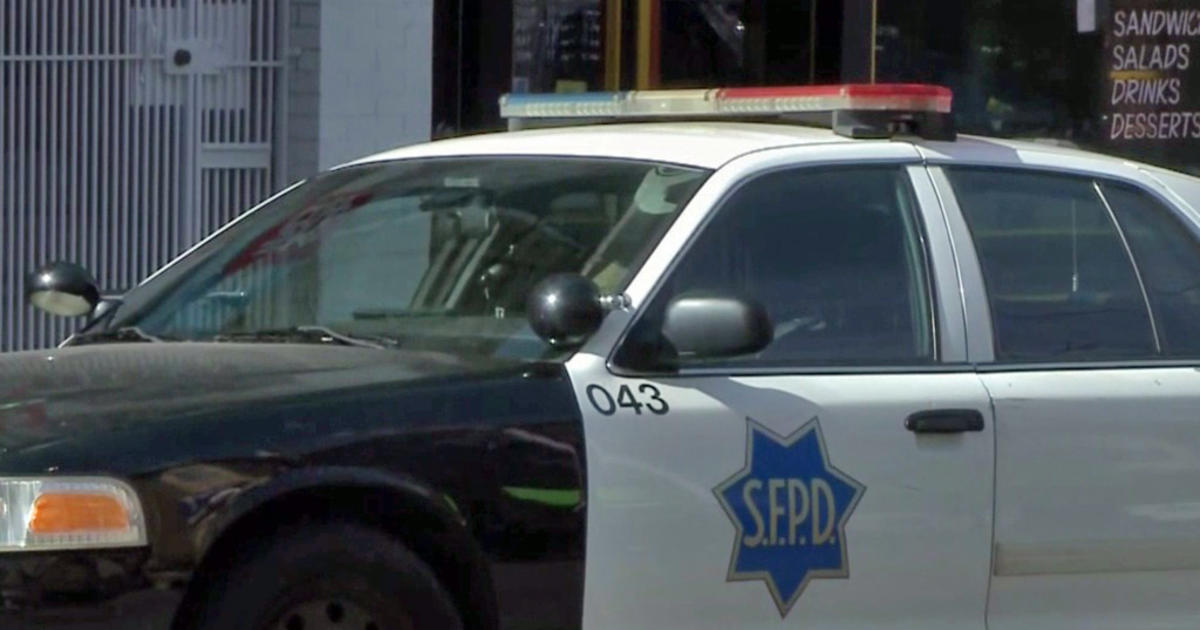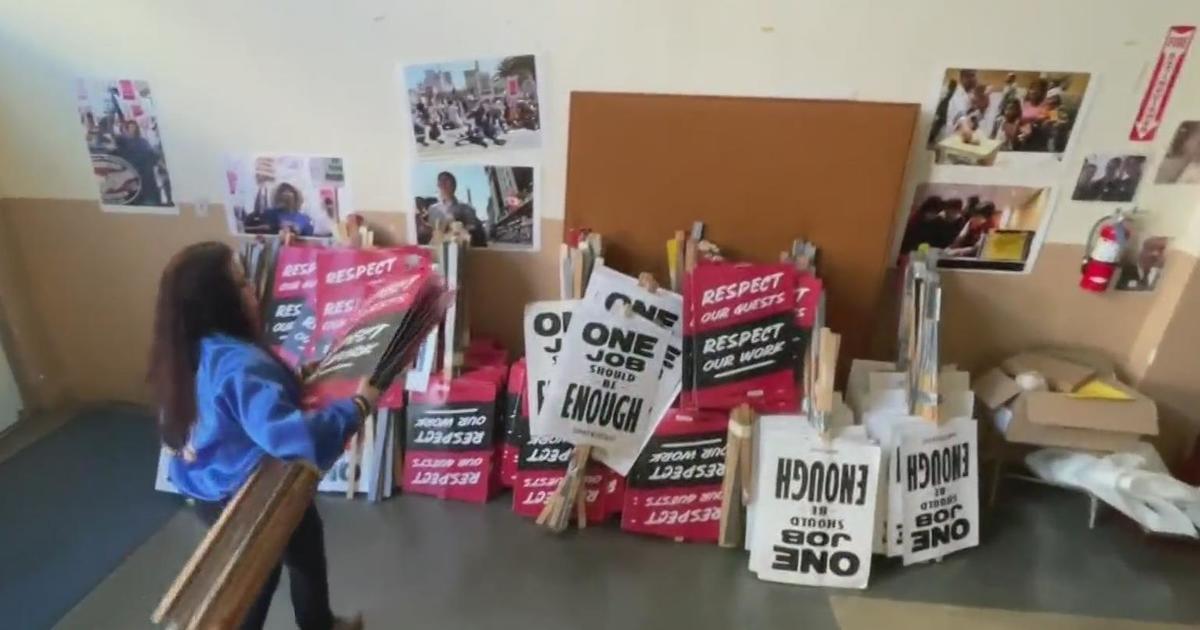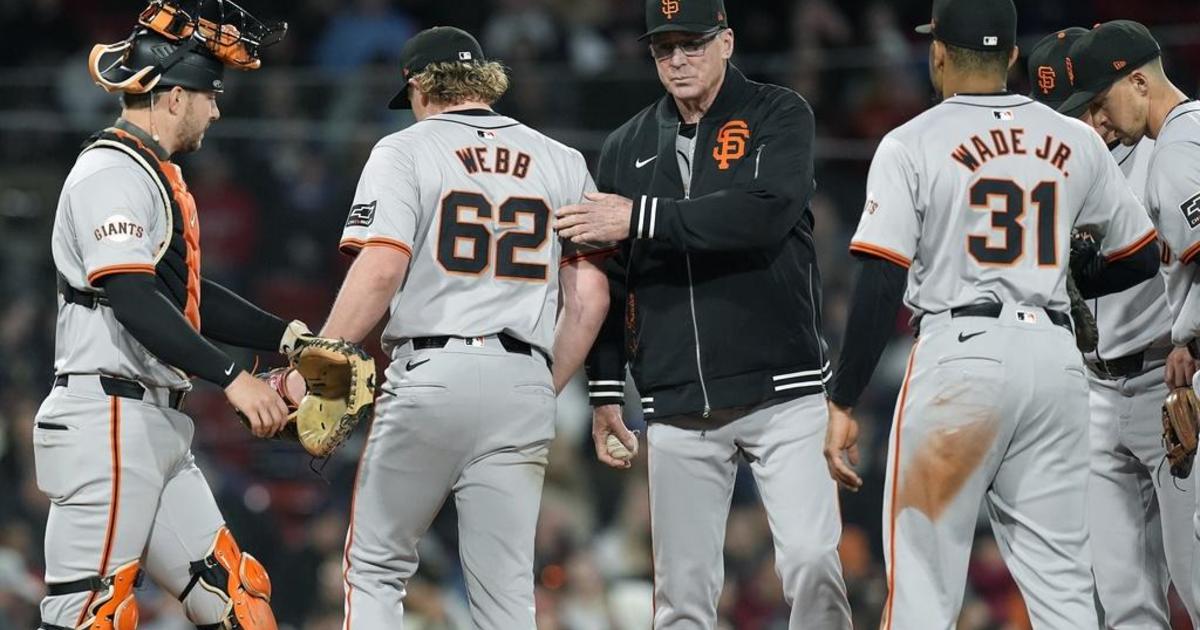CBS SF talks to famed British artist Roger Dean
SAN FRANCISCO -- One of the most distinctive artists to create album covers during the '70s and beyond, British illustrator and designer Roger Dean help shape the imagery and visual aesthetic of the era with his work with Yes, Asia, Osibisa, Uriah Heep and a number of UK record labels.
A graduate of the Royal Academy of Art in London after studying architecture and furniture design, Dean would fall into doing album art by happy accident after designing a seating area for Ronnie Scott's Jazz Club. His first album cover for the hard rock band Gun would lead to more design work for record labels including Vertigo Records and Fly Records (including a number of early Marc Bolan singles) before his striking album covers and logo for the London Afrobeat band Osibisa established Dean as a major talent in the field.
The artist designed stunning covers for a number of notable UK groups including Uriah Heep, Budgie and Gentle Giant, but Dean would find even greater fame for the fantastical imagery he created that adorned record covers for iconic progressive-rock group Yes starting with the band's breakout album Fragile that has continued to the modern era. Dean and his brother and fellow designer Martyn would also collaborate on stage set design for the band on a number of tours during the '70s and into the '80s and beyond, bringing the otherworldly vision of his album art into three-dimensional reality. His work would become popular enough that artwork from albums and original pieces became popular posters. Dean produced the first of what would be a number of books featuring his art.
Dean would also create the logo and album covers for '80s prog-rock supergroup Asia as well as venturing into video games, doing design for both game environments and packaging including a redesign of the logo for the popular game Tetris, all while continuing his work in architecture and furniture design.
Dean recently spoke to CBS SF about several projects he is currently involved with in the Bay Area. Late this summer, the Haight Street Art Center opened "The Secret Path: The Art of Roger and Freyja Dean", an exhibition spotlighting the master's work alongside that of his talented daughter through the end of October. Dean is also not only among the artists appearing at the TRPS Festival of Rock Posters at the Hall of Flowers in Golden Gate Park on October 15, but is also collaborating on a special poster commemorating the event. He is also working with Gray Area and Chambers Obscura on Dragon's Dream: The Roger Dean Experience, an immersive exhibit that will allow attendees to walk through the artist's creations and landscapes brought to life with laser projection and animation that opens in the Mission District on November 12.
Note: This interview has been edited for clarity.
CBS SF: You've said landscapes and moving through them were your biggest inspirations as far as your art. Do you think it was the diversity of your experiences as a child growing up and being exposed to places like Greece and Hong Kong that opened your mind to creating the otherworldly image imagery that you've become known for?
Roger Dean: You know, when you're a kid, you just take everything for granted. You don't realize it's special. I did love Hong Kong. That has to be said. It was amazing for a kid. Where we lived in Hong Kong was a place called Kowloon. Kowloon is named after nine hills. "Kow" means nine, "loon" means dragon. So it's the nine dragons; the nine hills or small mountains.
There were a lot of similarities…it's very odd, but I could say [a lot of similarities] to the hills above Malibu. A lot of similarities with Greece too, or Cyprus anyway. I remember Cyprus much better than Greece because I was very young when we left Greece for Cypress.
I guess the thing I remember most about Greece is people shooting in the streets. And my mum being very anxious about lots of guns going off right outside and then discovering they were actually celebrating. So it was not actual fighting. Though there was a lot of fighting when we were there. It was at the tail end of the second civil war
CBS SF: To get into your early album artwork, I guess the debut album by Gun is the first cover that you did. One thing that strikes me about it is there's a darkness to that cover design that really stands out. Not that Yes ever did anything that would call for that kind of imagery, but it's very different from most of your other work. I was wondering if you were inspired by the band and their music? They had a song called "Race with the Devil," so that would go hand in hand. But I also think I heard that it was taken from a sketchbook you had and was done before you were familiar with the band…
Roger Dean: The painting was essentially symbolic. I needed something to symbolize an outside elemental force to contrast [with] domestic security. It was done for my thesis on architecture. It didn't get used in my thesis, probably wisely. But that was what it was done for. It was to demonstrate something where domestic security had something to be secure from: stormy weather, whatever. But something primeval, not street crime.
So I had that sketch and Ronnie Scott and Jimmy Parsons, his partner, said, could they use it for this cover for the Gun album? And I thought, "That sounds fun, but no. I'll do it again." So I did it again. It's not from the sketchbook, but it's a revisit of it.
CBS SF: And at that point, you still hadn't heard the music? Did the music come into play at all?
Roger Dean: Actually, what I say is that, when I do album covers, I very rarely get a chance to hear the music, because I usually have to do it before the music is finished. But in the case of the Gun album, they had a hit single when they asked me to do the cover. So I had heard "Race with the Devil."
CBS SF: I knew that you designed the Yes logo, but it wasn't until I was going back through a lot of your other artwork that I realized you designed the logos for a number of different bands including Obisa, and I'm assuming the Gun logo on that album cover was also yours and you just incorporated it after the fact. It seems like a lot of the logo and typography design is very intrinsic to the covers. Do those two aspects kind of go hand in hand as far as your creative process? Or do you do the art and then do the typography or logo design separately and put them together after the fact?
Roger Dean: I think there is an attempt. I won't go more than to just say there is an idea around creating another world where the music comes from. And it doesn't work if you use Helvetica. At best, it looks like a piece you've captured and put in a museum. You've domesticated it. So for me, it did need a different look to the catalog. Helvetica, Gill Sans all those fonts that were very popular and still are with graphic designers. Bless them [laughs].
CBS SF: One thing I did not know about prior to doing research for this interview was that you and your brother designing the retreat pod that appears in A Clockwork Orange...
Roger Dean: Yeah, that was my brother.
CBS SF: Was that entirely your brother's work? I saw some things online that credited you and Martyn as designing it.
Roger Dean: Yes, the retreat pod was entirely him, because he'd already built it. Stanley Kubrick borrowed it. He didn't ask Martyn to design it. He asked if he could borrow it. And Martyn designed the stage for the Relayer tour. That was entirely him. I did the fabric backdrop, but he did all the hardware on the stage. We worked together on the Tales of Topographic Oceans tour. He also did the Drama [tour stage design]. We swapped about what roles we would take.
CBS SF: This might be a little off base since you did not have a hand in designing the pod used in the Kubrick movie, but were you ever interested in doing production design for film? In some ways, it seems especially the more futuristic aspects of some of your art would make you a natural as far as doing concept art.
Roger Dean: It's complicated. We've been asked, collectively, a lot of times to do it. But one of the key things about working on movies is they own it. And I thought, "Nah. I'm not gonna go there." We did once get asked by Dino De Laurentiis to design...I think it was just the costumes for Flash Gordon. And I thought, "No, I don't really want to do this." But I introduced him to Chris Achilleos, who did design the costumes. And that was good.
But I did actually talk to him [De Laurentiis] about a different project. And I thought, "How am I going to present this in such a way that, if he's interested, there won't be this discussion about the film company owning it?" So I talked to him about working as a co-producer on a project, and he was up for that. In that circumstances, I didn't have to part with the ownership. I'd have to give them a license, but I didn't have to give up ownership. So there are ways, but normally if they're not going to steal it, they want to own it. And the thing about stealing it is that they don't own it.
CBS SF: I knew that you'd done the Vertigo and Virgin logos, but even though I have some original Marc Bolan singles, I did not realize you had created the Fly Records logo. The logo design that you did, was that an outgrowth already working with those labels as far as providing them with with artwork for records that they were putting out?
Roger Dean: Well, I'd been designing labels for Virgin for some years before they finally got the record label together. I've got a print of the Virgin logo down in the Haight Street Art Center show, and it's numbered six and seven, respectively, because that's what they were. When Richard first said to me, "Can you just give me a record label?" I said, "Sure." But he didn't have a record company. So they got used on carrier bags and things in his shops. Same for the second, third, fourth. I think it was the fifth one when they finally got their act together to have a record company. And it was very successful, as you know.
CBS SF: It's interesting that the Vertigo logo really seems an early example of the floating world landscapes you would further develop both with Yes, and another other artwork...
Roger Dean: Well, I need to be clear, just in case there's people who are interested in the history. The original Vertigo label, which was the spirals, right? When you look at it [when it spins on a turntable] creates a sense of vertigo, I guess. That was originally designed by Linda Glover. Not me. When you say I designed the Vertigo label, that was when I made it a pictorial label and the spiral logo was still being used. By then I had done quite a few album covers for Vertigo.
CBS SF: I did an interview with Mick Box from Uriah Heep a few years ago...
Roger Dean: Nice guy!
CBS SF: Yeah, he was very charming and we had an excellent chat. We discussed the artwork that you did for Demons and Wizards and The Magician's Birthday. I asked him if there was a reason they didn't continue working with you after that and he said something about Yes using you almost exclusively after the second record cover you did for them. I wasn't sure about the accuracy of that, since I thought you were doing work for other bands in the early-to-mid 1970s...
Roger Dean: To be fair, I have done some since.
CBS SF: Oh, you've done more covers for Uriah Heep? I guess there was a reissue of Magician's Birthday that I recall having sort of a reimagined version of the cover...
Roger Dean: Yes, I did that, but I did other albums for them as well. The thing about the albums I did for Uriah Heep, they didn't really look like Yes albums. I didn't think so anyway. The same issue applied much more forcefully when Asia was formed, because Asia had half its members from Yes. Steve Howe and Geoff Downes were both members of Yes with Geoff Downes playing keyboards on the Drama album. The other two guys [John Wetton and Carl Palmer] didn't want Asia to look like a alternative Yes band. They wanted it to have its own identity.
So I wasn't going to work on that, but Steve is a friend. And I remember going into the studio one day and he had all these designs on a grand piano with various ideas. And I was looking at them while they were recording, and when they finish whatever track they were doing, I said, "You don't really have a cover yet, do you?" And they said, "No, not yet." And I said, "You know, I could do something that didn't look like yes, you know, I could do a dragon. I can do a logo that was all hard edges and sharp corners." And so they said, "Okay, go for it!" And I did.
CBS SF: It seem you and Steve must have a pretty close relationship. I know you also did covers on his solo records in the in the '70s.
Roger Dean: Some, yeah.
CBS SF: And one of those interestingly incorporated your art along with photography, where he was standing in one of your landscapes...
Roger Dean: That's actually him him standing inside a piece of architecture.
CBS SF: Oh, was it? So he's standing in something you designed? Okay. That makes sense. Besides fantastical landscapes, there are occasions where you use fantastical creatures and like dragons. I want to get a UK copy of the Gentle Giant album Octopus, because that's one of my favorite images I think that you've ever you've ever done. I still haven't tracked one down. But I was curious if you ever study zoology as far as the launching point for some of those creations?
Roger Dean: Not really. My daughter did. She studied natural history and scientific illustration. And she went on to do science and art and she did work at the Royal College of Surgeons and did a course on forensic facial reconstruction. So she had a much more intense grounding in that. But even before she went to college, she had a great intuitive grasp about how the mechanics of living things worked. She would often correct my mislaid anatomy, if you like [laughs]. She would say, "You know, that isn't how the elbow would work. It needs to be like this." So yeah, she she was actively involved from a quite a young age and sorting out my anatomy [in my art].
CBS SF: What led her to follow your footsteps into art? Was she artistically inclined as as a child? Or was she watching you work and seeing what you created and just decided it was something she'd want to do too?
Roger Dean: Well, this is a question you'd need to ask her. I do remember on one occasion that she was doing a drawing and she had an uncle visiting. He was looking at what she was doing and saying, "Wow, Freyja that's really good. Are you going to be an artist when you grew up?" And she looked at him really indignantly -- she was about four or five -- and said, "I already am!" [laughs]
CBS SF: Sounds like my daughter.
Roger Dean: And I thought, "Yeah, why not? You are." And then she came up to me afterwards and sort of half whispered and said, "Dad, I hope you don't mind. I don't want to be an artist." And I said, "Sure, you can be whatever you like, why not?" And she said, "You know some of the best artists in the world, and they're all broke." [laughs] Yes! Think about that. That is an aspect of life if you're an artist. The world's not going to give it to you on a plate. You've got to fight for it.
CBS SF: I wanted to ask about another aspect of your art that comes up specifically in a couple of album covers. Human or humanoid figures come into play with some of your album artwork, but perhaps not as frequently as landscapes and creatures. The couple of covers where you use human figures I was thinking of seem really distinct, where the human figures are almost alien. They're the covers for the Babe Ruth First Base album and the one you did for the Patto album Hold Your Fire...
Roger Dean: The Patto one, I gotta say, that was their gig. It was their idea. I really don't know why I ended up doing it, because there was nothing for me to do except draw what they drew. And so that was, in a way, a kind of outlier in my work. I have painted figures. The Virgin logo is a drawing of a woman. The Astra robot was still a human. And there are quite a few figures in my paintings. But there seem to me to be a lot of people very focused on figures and it didn't seem to need any input from me.
CBS SF: In my preparation I was reading about the lawsuit you filed over the imagery used in the James Cameron film Avatar. Even though people involved with the film admitted they clearly took inspiration from your artwork, the case was dismissed, which seems ridiculous. That had me thinking about the many artists who created fantasy artwork during the '70s and '80s that was similar to your art. Was there ever a point where you took legal action on someone because they were maybe drawing too liberally from your imagery for inspiration?
Roger Dean: Well, it has to be said that no one has taken such wholesale lifting my work as the Avatar movie. It was the production designer -- not James Cameron -- who said that he studied my work and referenced it during the making of the film. He said, "You know, floating islands; where else would you go?" He did acknowledge it very much. So the judge I think, frankly, made a mistake. There was some serious copyright academics who said the judge made a mistake.
Basically, what he did is he summarized the main copyright law, which said that the work as a whole has to be substantially similar so that an ordinary person would see the similarity. That's the film taken as a whole and my work taken as a whole, they would have to see substantial similarities. Well three million people had said that it was a lift; that it was a take on my work. Also, they weren't really denying it. They did say, "Whereas we won't admit that we there was any copying, if there was however, we only copied things that you copied from nature."
Which is legitimate. If I draw a cat and they copy my cat, because the cat exists, I can't have a copyright on the cat. But I can have a copyright on my manifestation of the cat, right? If I give the cat a lizard tail, the tail might exist in nature and the cat might exist in nature, but the combination doesn't. So what I did in my evidence, I showed half a dozen different details that they copied specifically from it that didn't occur in nature. But the judge, reverting to this idea that the work has to be taken as a whole and you don't go into detail, he took all my evidence out. Then when he came back to the concept that I'm saying they copied in detail things that they claimed I'd taken from nature, my evidence was gone.
So yeah, it was not a very satisfactory outcome. It didn't go to court. That was the thing that was really frustrating. This wasn't a trial. It was a motion to dismiss. And he did. So I thought he was not really looking at it carefully. Not really doing his job properly, in my view.
CBS SF: I guess that's the problem. In the legal world, injustice happens all the time. It was certainly clear to me as soon as I saw it, I thought, "Well, that's really cool that I get it see these images in widescreen." I mean, in some ways, the best part of the movie was being able to experience your worlds in 3-D on that scale...
Roger Dean: That's also part of my thinking, too. I mean, part of me was really, "My God! All that stuff is mine!" And then another part of me was thinking, "My God, my stuff looks really great on the big screen." So there was that side of it, too.
That idea actually leads very nicely into my questions about the Dragon's Dream immersive exhibit at Gray Area. I was curious having been in the space which has a theater area, is this going to be a sit-down experience or more of a walk-through sort of exhibit?
Roger Dean: As I understand it, there will be some things to sit on, but it's essentially a walking around experience.
CBS SF: Was it difficult to narrow down the artwork that is being used for the exhibit? Will it be a mix of album covers and other paintings that might not be as familiar?
Roger Dean: I think it's gonna be a mix of stuff you will have seen and stuff you won't have seen. What they did -- which is surprising to me -- was they took different paintings, and they're kind of, where it's possible, made a wraparound world. My paintings don't really join like that, but there are technical skills involved in making sure they do join like that.
And some of them do use a common palette, so it's easier. Others they have to change the palette. So it's a complicated process and it's still being thrashed out and resolved. It's not a done deal. There are aspects of it that are quite challenging and there are aspects that are amazing. So I'm hoping it's going to be as amazing to others as it is to me, in my mind, because I haven't really seen it yet.
CBS SF: Right. I guess if it hasn't been staged yet, it sounds like there are some technical aspects that might take some ironing out. But it does sound like almost a visual remix of your body of work.
Roger Dean: I think that has to be sorted out. But the technology that's projecting it, I mean, I do have faith that it is going to be absolutely mind blowing. The amount of detail and that you can walk right up to it and touch the screen as it were. I don't know if they would like you going out and touching the screen, but that's what they said to me when I was in the demo, that you can touch the screen.
CBS SF: Is there an animation aspect to it as well, or is it more strictly immersive, static sort of three-dimensional environment?
Roger Dean: It's a little bit like a slideshow, but that can be very unfair on how intense and huge and immersive it feels. But it's not immersive like...you're not wearing goggles. So you can walk around in the space. I would say at the moment we're finding our feet. And I think whatever happens is going to be a bit of a surprise to all of us on the day. Hopefully it'll be an amazing surprise. It's challenging in that I don't really know how it's going to be at this point. But right now, it's a work in progress. I mean, it's almost as scary as a painting that's half finished. I never doubt that the painting is going to work out. I just relax into it. And that's how I feel about this.
CBS SF: In regards to the Haight Street Art Center exhibit, I know you you and your daughter curated it. One thing I was going to ask is have you and your daughter actually collaborated on a single painting?
Roger Dean: We have done occasionally, yeah. It's kind of a fun exercise, but it's not serious serious. Although she has, as I said to you earlier, looked at some of my paintings and fixed them.
CBS SF: As far as you curating the the exhibit together, did you find there were pieces that complemented each other as far including them in the exhibit? With the brief overview I did looking at her work, there are certain similarities in the psychedelic aspect I can see in both of your paintings, but they're very distinct. Did you collaborate as far as which paintings you would put into the exhibit?
Roger Dean: No, not really. We didn't need to. It never at any point seemed to be necessary. I mean, to a degree, I didn't know what she was doing because half of her work was brand new. So I hadn't even seen it until the day before it opened, pretty much.
But it's odd, because to me, I don't really see my work is absolutely psychedelic. It's different to what that movement was about, but it fits. There is a certain color usages, certain parts of the palette of my work, especially in the lettering, that fit right into that psychedelic movement. But that doesn't exist with her art. She doesn't use those colors. She use entirely different palette and yet, somehow, her work is much more psychedelic. I think she uses an entirely different palette than I and that era, and yet it's more intensely psychedelic than almost any work I've ever seen.
CBS SF: You're also involved in the TRPS Festival of Rock Posters in Golden Gate Park in October. Is that beyond doing the design of the poster for the event?
Roger Dean: I've been asked to appear at it and I've said yes, so I'm looking forward to that. I'm currently working with Zoltron, who's a San Francisco artist, very clever guy. We're doing the poster together. It's on the 15th of October. And that's before my other show finishes on the 30th. So I'm going to become back mid-October to do stuff for the other show as well. I think I've got to be back and forwards quite a bit, because on top of everything else, I'm going to be doing some dates with Yes. So it's going to be a busy autumn.
CBS SF: As far as doing dates with Yes, what does that entail? What will you be doing with the band?
Roger Dean: Basically I have a small exhibition on tour with the band. And, I guess I'll be signing a lot of stuff for people. It's great meeting all the Yes fans. I love that. That's in October and November. It's going to be very tricky scheduling!
